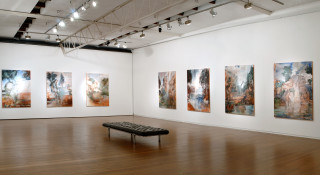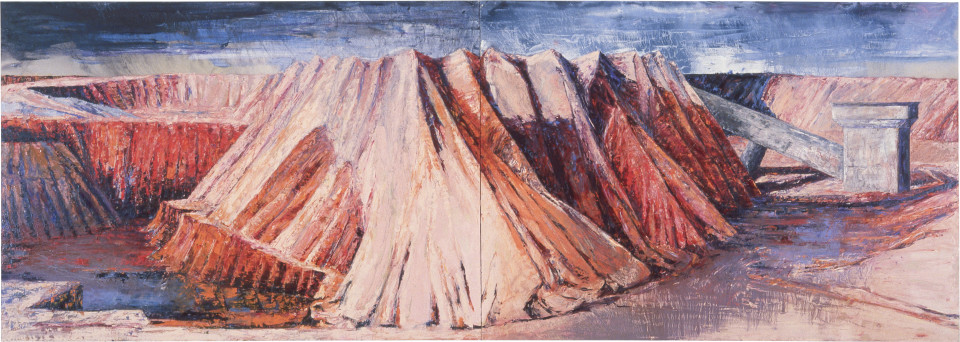Mandy Martin's paintings represent one possibility. Attempting to control nature in the name of progress meets a watery end at the high tide mark, a case of an irresistible force thwarted by meeting objects already on the move.
Exhibition Dates: 22 April – 10 May 1986
"The tyme away dothe waste
And the tide, they say, tarrieth for no man."
Nicholas Uvedale, Ralph Roister Doister, c.1552.
Futile to protest that tides flow and circumstances ebb. In deference to these changeable certainties and in reference to human powerlessness in the matter notable stands have been taken at the watery edges of this apparently stable world. Canute and Don Dunstan, one thousand years and half a hemisphere apart, had this much in common, public relations notwithstanding: both appreciated the paradoxical power of the theatre of the impossible. And the players in the drama? The forces of nature meeting the hopes of mankind.
In a sense we start considering polarities at the shoreline, where nothing is fixed, all shifting yet solid, both wet and dry, natural and social, littered with objects out of time yet grounded fast in history, like becalmed barques run ashore. This very fluidity is the metaphorical mother of change. Time plays here. Temporal change is particularly suggestive in this transitional zone between land and sea, where both are engaged but neither privileged in a final balance. Desert landscapes carry a promise (or a threat) of a certain timelessness. But here at the water's edge all is movement and the conviction that nothing is certain under the sun.
What is natural, then, and what of human manufacture? Let's start by saying that nothing is natural where we are. Romantic painting (and after) took up positions at crucial conceptual intersections (crossroads in history?) where the natural and social meet, where earth, air, fire and water mock the puny powers of science and industry, marrying potentiality and pathos. Paradoxically, some European canvases speak of human insignificance in the face of this insuperable strength. Yet art sought to master nature quite as surely as science did, picturing the land ultimately to possess it. So how are these traditions to be turned about and against themselves?
Mandy Martin's paintings represent one possibility. (This too has its history in western painting: I'm thinking here of Caspar David Friedrich or the tempests of Turner.) Attempting to control nature in the name of progress meets a watery end at the high tide mark, a case of an irresistible force thwarted by meeting objects already on the move. Plays between history and nature suggest complex gambits. They refute water-tight distinctions between the timeless and natural on the one hand, and social narratives on the other. History has its ironies, but natural forces take their revenge, like the blind and implacable figure of Justice.
What do we have here? Abstract concepts or concrete locations? Real or imagined? A universal question or a tragedy particular to a future time or a place well known from the past? Moot points. Whether these ramps of concrete and squares of steel are useful or useless it is impossible to say; either way they act as the replaced structure of the cliffs themselves, a prosthesis where once another armature stood solid. Either or both: here we see history made before our very eyes, no conjuring trick, rather the possibility painting offers as its substance slips and slides and moves with the times. See the pigment in currents and eddies, oil rather than water the appropriate medium, holding imported powders apeing native clays, Naples Yellow, Indian Red and Burnt Sienna in place of the original red ochres reflected in the waters of the bay. Such a play of oppositions makes the passage of time and the passing of histories. Thus we see the true meaning of obsolescence: that each moment is pregnant with its own destruction. Who can afford to be indifferent, and who can be quite certain?
Landscape has astonishing histories in Australia. The Centralian desert pictures, even the brilliant sunlit Flinders Ranges of Hans Heysen, represent a journey into the self, a persona pinned down, seen and feared to be arid but not any the more accessible for all that. I'm interested that these paintings turn their backs on that Centralia, another country of the mind's eye, a projection of fear and desire that finds meaning in substance.
Who sees these scenes? Only we do, for landscapes are always fictional. And from what vantage point? Are we all out at sea, tossed by the tides and pulled by half-understood currents? Or is this a place to begin again, a new perspective for future plans and possibilities? And whom do we see? Nobody, for nobody is in the picture, as it were. Only we are "in" the pictures, by standing outside them (right here) in the place we might have been and might yet end up, close in but at a contemplative distance, not storm-tossed but taking stock.
This is a modern tale in Australia (among other places), a desperate search for industrial viability, its apparent failure and replacement by newer industries. What is anachronistic in these images? The ruins or the hopes they still stand for? The physical substance of the land has been ravaged by its passage through successive landscapes of social ordering: erosion ditches and the blowing dusts of mountain ranges say as much. Here evidence of despoliation is seen at the limits of the land, signalling the pathetic inutility of this industry in the place where it has displaced forever another history, the long quiet crumbling of the cliffs into the sea, the creeping sands, the appropriate purposefulness of migrating birds. The Aboriginal peoples of this area once mined it for ochres, where "The Blood Ran Down to the Sand." They were not yet another natural phenomenon nor a guarantee of a state of grace, but simply a less destructive human agency in the history of these shores than the last one hundred and fifty years have seen.
These exigencies are passing now, redundant or defunct, as employment needs and the material demands of our culture change in these dying years of the era of Progress. But there are no guarantees of the efficacy of the future once again before us. Here is a speculative site for making art, these visible fictions, though whether historical drama or science fiction or even moral fable it is hard to say.
—Julie Ewington
Sydney, December, 1985
 Mandy Martin Wanderers in the Desert of the Real
Mandy Martin Wanderers in the Desert of the Real
Roslyn Oxley9 Gallery, 2008
 Mandy Martin Salvadoresque
Mandy Martin Salvadoresque
Roslyn Oxley9 Gallery, 2006
 Mandy Martin Absence And Presence
Mandy Martin Absence And Presence
Roslyn Oxley9 Gallery, 2004
 Mandy Martin Salvator Rosa series IV
Mandy Martin Salvator Rosa series IV
Roslyn Oxley9 Gallery, 2002
 Mandy Martin Salvator Rosa Series II
Mandy Martin Salvator Rosa Series II
Roslyn Oxley9 Gallery, 1999
 Mandy Martin Recent Works
Mandy Martin Recent Works
Roslyn Oxley9 Gallery, 1997
 Mandy Martin
Mandy Martin
Roslyn Oxley9 Gallery, 1995
 Mandy Martin
Mandy Martin
Roslyn Oxley9 Gallery, 1993
 Group Show, Christmas show
Group Show, Christmas show
Roslyn Oxley9 Gallery, 1991
 Mandy Martin
Mandy Martin
Roslyn Oxley9 Gallery, 1991
 Mandy Martin
Mandy Martin
Roslyn Oxley9 Gallery, 1989
 Group Show, The Cocktail Party (All Gallery Artists)
Group Show, The Cocktail Party (All Gallery Artists)
Roslyn Oxley9 Gallery, 1988
 Group Show, Chaos
Group Show, Chaos
Roslyn Oxley9 Gallery, 1987
 Mandy Martin
Mandy Martin
Roslyn Oxley9 Gallery, 1986
Mandy Martin
Roslyn Oxley9 Gallery, 1984
Group Show, Australian Visions
Solomon R. Guggenheim Museum, New York, 1984













